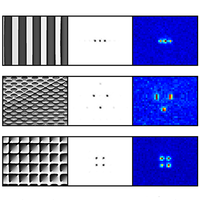Abstract
We demonstrate single-atom trapping in two-dimensional arrays of microtraps with arbitrary geometries. We generate the arrays using a spatial light modulator, with which we imprint an appropriate phase pattern on an optical dipole-trap beam prior to focusing. We trap single atoms in the sites of arrays containing up to approximately 100 microtraps separated by distances as small as , with complex structures such as triangular, honeycomb, or kagome lattices. Using a closed-loop optimization of the uniformity of the trap depths ensures that all trapping sites are equivalent. This versatile system opens appealing applications in quantum-information processing and quantum simulation, e.g., for simulating frustrated quantum magnetism using Rydberg atoms.
3 More- Received 21 February 2014
DOI:https://doi.org/10.1103/PhysRevX.4.021034
This article is available under the terms of the Creative Commons Attribution 3.0 License. Further distribution of this work must maintain attribution to the author(s) and the published article’s title, journal citation, and DOI.
Published by the American Physical Society
Popular Summary
Optical tweezers, invented more than 30 years ago, are essentially very tightly focused laser beams that are used to trap and manipulate small particles such as polymer beads, living cells, and even laser-cooled atoms. Based on a careful choice of experimental parameters, it is possible to ensure that a single atom can be trapped in the tweezers, which opens up exciting new perspectives for the engineering of quantum systems. Using the strong interactions existing between Rydberg atoms—highly excited atoms in which an electron orbits far away from the nucleus—results have recently shown that it is possible to create entangled states of two neutral atoms. Extending these demonstrations to a larger number of atoms is currently an active area of research; an experimentally appealing technique is generating large arrays of optical tweezers for single-atom trapping.
We demonstrate the trapping of single atoms in two-dimensional arrays of optical tweezers containing up to 100 traps separated by as few as 3 microns. These arrays are generated using a spatial-light modulator to imprint an appropriate phase on the trapping laser. The array is produced at the focal point of a large numerical-aperture lens and is the diffraction pattern of the imprinted phase. The setup allows for the creation of almost arbitrary geometries of arrays of tweezers, including squares, triangles, and honeycombs. We take full advantage of the reconfigurable spatial-light modulator to ensure the quality of the arrays by compensating for optical aberrations and by using a closed-loop optimization of the uniformity of the tweezers’ depths over the array. We are able to reduce the variation in trap depth, ensuring that the trap depths are neither too low (translating into poor trapping probabilities) nor too high (opening up the possibility that more than one atom will be trapped simultaneously). The total power required for the traps is on the order of mW, well within feasible experimental bounds.
Arrays of optical tweezers make it possible to investigate the physics of ultracold atoms in reconfigurable arrangements without having to rely on traditional optical lattices.



